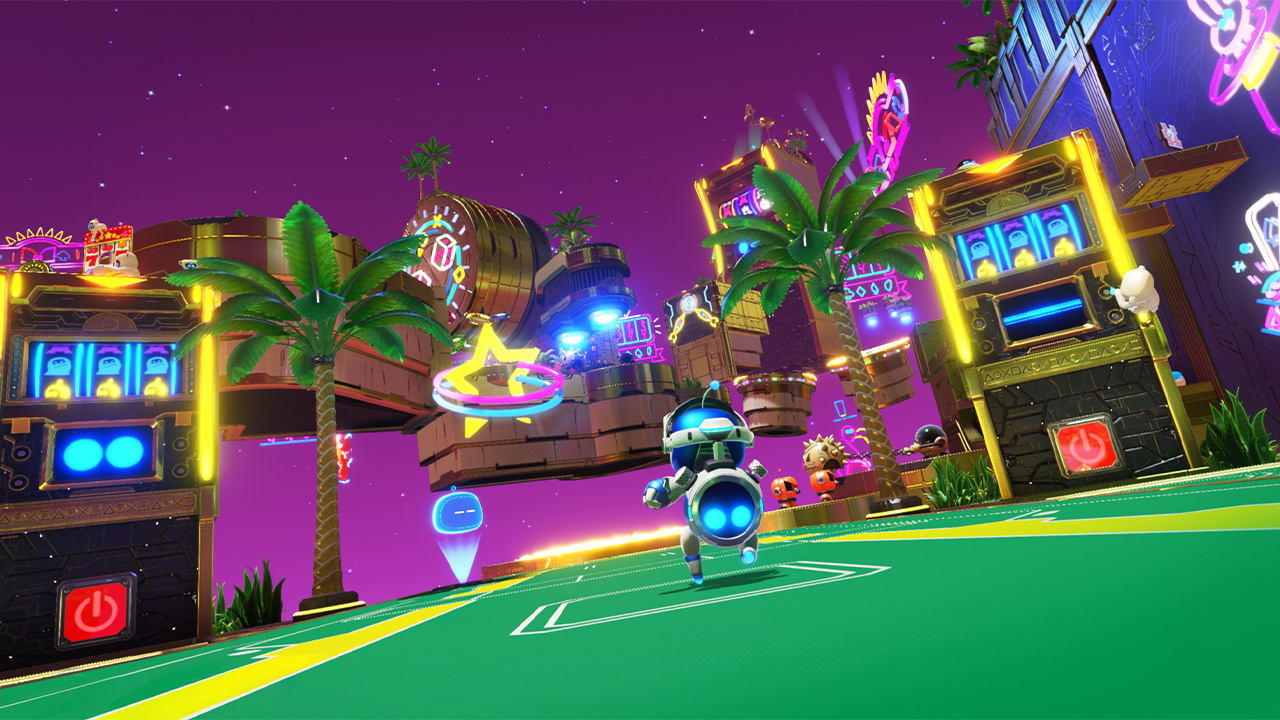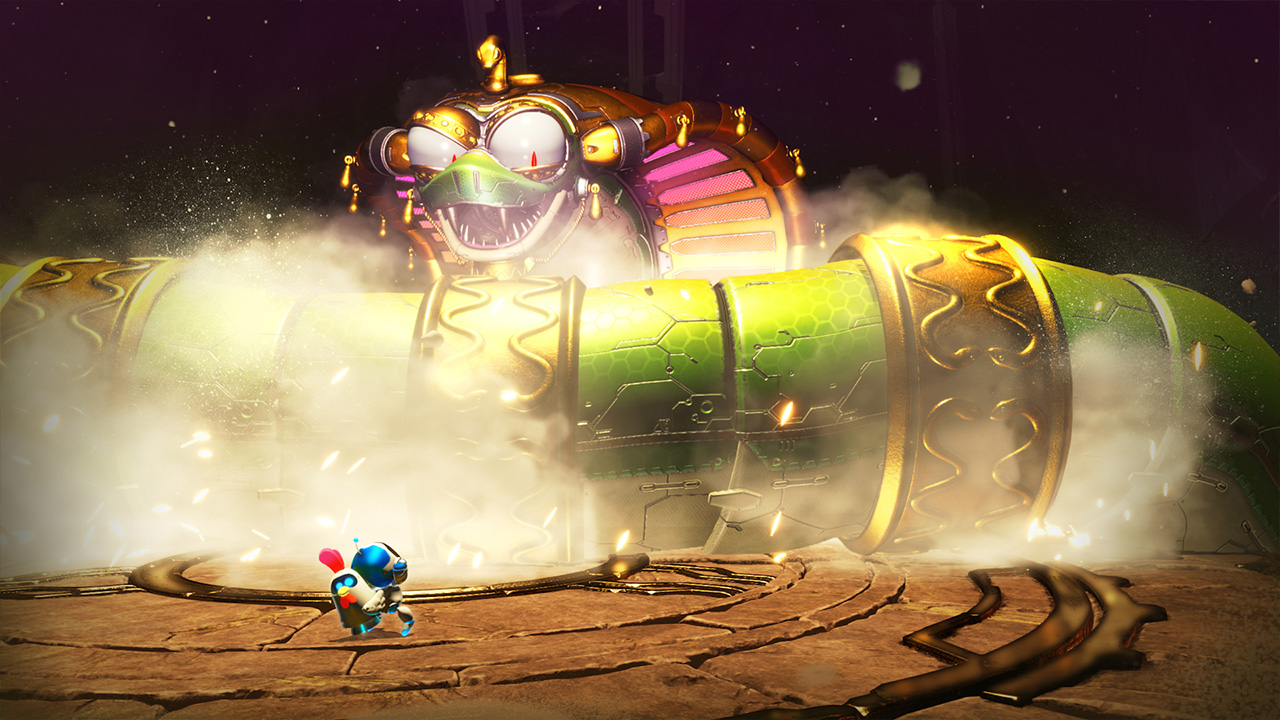You may have heard everybody sing Astro Bot’s praises lately, and that’s with good reason — it’s a masterclass in creative level design, fun for all the family to play, and cleverly leverages the past thirty years of PlayStation’s history to its benefit. When Team Asobi had to follow up on their free PS5 pack-in title, Astro’s Playroom, and create something that could be considered a fully-fledged game, they understood the assignment and excelled.
Expanding from Playroom’s confines of the PlayStation 5, Astro Bot and his band of Sony-themed sidekicks are now travelling through the Galaxy. Their journey takes an unexpected turn when they are intercepted by an Alien, reminiscent of the PSVR title Astro Bot Rescue Mission, who steals the ship’s CPU, scattering its parts and crew across varying nebula. After crash-landing on an uninhabited planet along with the ship’s hull and a smaller craft (that looks a lot like the special edition tie-in DualSense controller), it’s up to Astro and his team to travel through different worlds in search of his missing Bots, ship parts and to rescue that CPU rather than spend £699.99 for an upgraded PlayStation 5 Pro.
Each nebula acts as a traditional world, and each planet within is a level. Upon entering a new planet, you’ll be instantly struck by just how stunning the environment looks, as the catchy music of the returning Composer, Kenneth C M Young, fills its atmosphere. From here, you are tasked with the relatively simple sounding mission of finding hidden puzzle pieces and rescuing those adorable little missing Bots. Of course, it’s not always a simple process, as there will always be hidden objects to find, traps to avoid, puzzles to solve and various enemies with different attacks to defeat.
Different planets take on new theming across beaches, casinos, deserts, skyscrapers, haunted cemeteries and more. After you’ve cleared all of the planets in a nebula and provided you’ve found enough of your little Bot companions, it’s time to go up against that area’s big boss.
Each boss is contained within its planet and makes for an exciting battle when you look at the scope of the tiny Astro against a behemoth robotic Ape or Snake. Each encounter has been well thought out and is fun to play, usually incorporating a new mechanic learned during that nebula’s progression.
Much like Playroom before, Astro Bot must rely on different tools to help get the job done. New powerups include a pair of Frog Gauntlets that allow Astro to extend his punches as well as grab onto sticky objects, a Chicken Jetpack that boosts your jump in short but solid bursts and (the only non-animal themed) PS VR1 that can stop time for a brief period and freeze enemies or fast moving objects to be used as platforms. Each power-up is simple to understand – with less reliance on gimmick controls than previous titles but aids in adding a new dynamic to the already addictive platforming style.

Arguably, Astro Bot’s most impressive feature is its gameplay. It feels like some modern greats before it, like Super Mario Odyssey, Ratchet & Clank: Rift Apart, and Crash Bandicoot 4: It’s About time. Controls are kept simple but tight. This allows players of most ages to pick up and play through easily but also allows for those perfectionist runs, where you want everything to look just right as you bounce off platforms and progress with style. DualSense features have also been included with touch and motion controls – albeit less egregious than Astro’s previous outing – and the haptic feedback is used to react to whatever environment you’re interacting with.
Now, the real standout feature and reason why Astro Bot has become popular with mainstream audiences is the inclusion of PlayStation’s branding. Astro’s Playroom was used as a museum dedicated to Sony’s gaming hardware over the years. However, this pulls from the now thirty-year catalogue of games associated with various consoles. Bots themed around Uncharted, Ape Escape, and Horizon will pop up along the way, as will more multi-platform titles that have just been more popular with the blue brand, like Persona, Tomb Raider, or Tekken.
Instead of just seeing a PlayStation-themed Bot acting out a scene whilst you play through a level, you’ll bring them back to your home base, where they will live as you go off and adventure. As you return to the uninhabited planet to rebuild your ship, you’ll notice that the more bots you rescue will have gathered there, along with new unlockable areas to explore and upgrades to unlock. My favourite of these unlockables was the Gashapon machine that allowed you to unlock new costumes, skins for your DualSense spacecraft, and character objects for the PS Bots you’ve rescued – I got a loop for the Vib-Ribbon Bot to interact with. Now, all is right with the world.

The five PlayStation-inspired levels are another area where the gaming giant’s influence can be felt. Each level is based on a first-party Sony IP where Astro will become that game’s lead character, and you play a miniature version of that game. For instance, playing through the God of War Ragnarök will let you run around a recreation of Midgard as a tiny Kratos, throwing your Leviathan Axe, fighting with Nordic-themed baddies and taking down a giant robot pig called Nidhogg, all the while grooving to a dance remix of the God of War theme, complete with Christopher Judge’s “BOY” booming before the bass drops. Your mileage may vary depending on how big of a fan you are of PlayStation titles. Still, that experience alone justified the price of entry to me.
In total, I spent around twenty hours beating Astro Bot, making sure to get that Platinum Trophy shortly after rolling the credits. I thoroughly enjoyed myself during this time, smiling at all the PlayStation references and loving the smooth gameplay. The game outputted in 4K at 60fps without needing a performance or visual mode (which has been refreshing after many AAA titles I’ve been playing this year). Though I didn’t see any bugs or visual glitches, there was one hard crash about an hour before I’d finished the campaign – though I don’t think I’d switched the game off until the point other than rest mode, so that could be my fault.
If I had to find any fault in Astro Bot, once you’ve beaten its campaign and unlocked everything, there isn’t much else to keep you returning for more. I also found that though there are some difficulty spikes in the game’s hidden levels, nothing posed itself as a proper challenge. However, these downsides will be addressed with free DLC in the Fall.